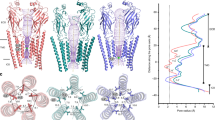Abstract
We conduct computational analyses of ion permeation characteristics in a model glycine receptor (GlyR) modified by photo-sensitive compounds. In particular, we consider hypothetical attachment to the channel of charge-neutral chemical groups which can be photo-activated by shining light of an appropriate wavelength on the system. After illumination, the attached molecules become charged via a photodissociation process or excited into a charge-separated state (thus generating a significant electric dipole). We carry out Brownian Dynamics simulations of ion flow through the channel in the presence of the additional charges generated in this fashion. Based on these calculations, we predict that photo-activation of appropriately positioned photo-sensitive compounds near the channel mouth can significantly modify the rate of ion permeation and the current rectification ratio. Possible implications for GlyR-based device designs are briefly discussed.






Similar content being viewed by others
References
Lynch JW (2004) Physiol Rev 84:1051
Cascio M (2004) J Biol Chem 279:19383
Keramidas A, Moorhouse AJ, Peter PR, Barry PH (2004) Prog Biophys & Mol Biol 86:161
Bartels E, Wasserman NH, Erlanger BF (1971) PNAS 68:1820
Lester HA, Krouse ME, Nass MM, Wassermann NH, Erlanger BF (1980) J Gen Physiol 75:207
Banghart MR, Volgraf M, Trauner D (2006) Biochemistry 45:15129
Kocer A, Walko M, Meijberg W, Feringa B (2005) Science 309:755
Borisenko V, Burns DC, Zhang Z, Woolley GA (2000) J Am Chem Soc 122:6364
Lougheed T, Borisenko V, Hennig T, Rueck-Braun K, Woolley GA (2004) Org Biomol Chem 2:2798
Cheng MH, Cascio M, Coalson RD (2005) Biophys J 89:1669
Cheng MH, Cascio M, Coalson RD (2007) Proteins 68:581
Cheng MH, Coalson RD, Cascio M (2008) Proteins 71:972
Graf P, Nitzan A, Kurnikova MG, Coalson RD (2000) J Phys Chem B 104:12324
Cheng MH, Mamonov AB, Dukes JW, Coalson RD (2007) J Phys Chem B 111:5956
Cheng MH, Coalson RD (2005) J Phys Chem B 109(1):488
Graf P, Kurnikova MG, Coalson RD, Nitzan A (2004) J Phys Chem B 108:2006
Lobo IA, Mascia MP, Trudell JR, Harris RA (2004) J Biol Chem 279:33919
Lynch JW, Han NL, Haddrill J, Pierce KD, Schofield PR (2001) J Neurosci 21:2589
Cascio M, Shenkel S, Grodzicki RL, Sigworth FJ, Fox RO (2001) J Biol Chem 276:20981
Keramidas A, Moorhouse AJ, Pierce KD, Schofield PR, Barry PH (2002) J Gen Physiol 119:393
Moorhouse AJ, Keramidas A, Zaykin A, Schofield PR, Barry PH (2002) J Gen Physiol 119:411
O’Mara M, Barry PH, Chung SH (2003) PNAS 100:4310
Yushmanov VE, Mandal PK, Liu Z, Tang P, Xu Y (2003) Biochemistry 42:3989
Unwin N (2005) J Mol Biol 346:967
Kurnikova MG, Coalson RD, Graf P, Nitzan A (1999) Biophys J 76:642
Im W, Roux B (2002) J Mol Biol 322:851
Corry B, O’Mara M, Chung S-H (2004) Biophys J 86:846
Cardenas AE, Coalson RD, Kurnikova MG (2000) Biophys J 79:80
Coalson RD, Kurnikova MG (2005) IEEE Trans Nanobiol 88:3745
Jun S, Becker JS, Yonkunas M, Coalson RD, Saxena S (2006) Biochemistry 45:11666
Acknowledgements
We wish to thank S. Essiz for her valuable assistance preparing the figures. We gratefully acknowledge computational support from Center for Molecular and Materials Simulation (CMMS) at the University of Pittsburgh. The work of MHC and RDC was supported in part by NSF Grant No.CHE-0518044 and ARO-MURI Grant No. DADD19-02-1-0227.
Author information
Authors and Affiliations
Corresponding author
Rights and permissions
About this article
Cite this article
Cheng, M.H., Coalson, R.D., Cascio, M. et al. Computational prediction of ion permeation characteristics in the glycine receptor modified by photo-sensitive compounds. J Comput Aided Mol Des 22, 563–570 (2008). https://doi.org/10.1007/s10822-008-9200-0
Received:
Accepted:
Published:
Issue Date:
DOI: https://doi.org/10.1007/s10822-008-9200-0




